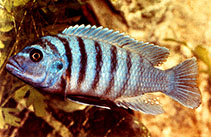| Family: |
Cichlidae (Cichlids), subfamily: Pseudocrenilabrinae |
| Max. size: |
11.3 cm SL (male/unsexed) |
| Environment: |
demersal; freshwater; pH range: 8 - 8; dH range: 9 - 19; depth range 6 - 28 m |
| Distribution: |
Africa: Lake Malawi in Malawi (Ref. 5595, 27596), including Likoma Island and Chizumulu Island (Ref. 5595). |
| Diagnosis: |
Dorsal spines (total): 16-19; Dorsal soft rays (total): 7-10; Anal spines: 3-4; Anal soft rays: 6-9. Diagnosis: The moderately sloped head, swollen rostral tip of the neurocranium, isognathous jaws, and the presence of bicuspid teeth in the outer rows of the jaws place this species in Maylandia (Ref. 27596). The absence of any interrupted pigment in the pale blue dorsal fin in combination with black bars on a blue ground colour distinguish this species from all other members of the genus (Ref. 27596).
Description: Jaws isognathous; teeth on jaws in 2-5 rows; majority of teeth in outer rows bicuspid, with a few posterior unicuspid teeth; those in inner rows tricuspid; 3-14 teeth in outer rows of the left lower jaw (Ref. 27596). Dorsal fin with 16-19 spines and 7-10 rays; pectoral fins with 12-15 rays; anal fin with 3 spines, except in some specimens from Mazinzi Reef and Mitande Rocks, which had 4; anal fin with 6-9 rays (Ref. 27596). Lower pharyngeal bone triangular in outline (Ref. 27596). Scales along side ctenoid; 29-34 lateral-line scales; 0-3 pored scales post lateral line; 4-6 scale rows on cheek (Ref. 27596, 76849). First gill arch with 9-14 rakers on the ceratobranchial, 1-5 on epibranchial, and 1 between the epibranchial and ceratobranchial (Ref. 27596).
Colouration: Breeding males have a blue ground colouration laterally with 6-8 black vertical bars, very faint or no bars on posterior one-third; although extremely rare, sometimes they exhibit a blue/black or orange/black blotched colouration; belly anterior to the pelvic fin black fading to light blue posteriorly; head dark blue to black with a single light interorbital bar; gular dark gray in most populations, but yellow in some northern populations; dorsal fin uniformly blue gray in most populations, with tips of posterior rays orange in some populations and a continuous black horizontal stripe in some northern populations; caudal fin blue/gray; anal fin blye gray with 1-5 yellow ocelli; in some populations the proximal two-thirds of the anal fin is black, while the distal one-third is light gray; pelvic fin light blue leading edge, spine and first two rays black, posterior rays clear; pectoral fins clear (Ref. 27596). Females generally with brown cast and 1-4 faint ocelli on anal fin; the females alternatively may be dull blue or exhibit an orange/black blotched colouration; this blotched colouration is observed more frequently in females than males and appears to be completely absent in some populations (Ref. 27596, 76849). |
| Biology: |
Found in rocky areas which may be sediment-free and shallow or sediment-rich at somewhat deeper levels. Feeds at right angles with the substrate by combing loose material from the biocover. Also feeds on plankton in the open water (Ref. 5595). |
| IUCN Red List Status: |
Least Concern (LC); Date assessed: 22 June 2018 Ref. (130435)
|
| Threat to humans: |
harmless |
Source and more info: www.fishbase.org. For personal, classroom, and other internal use only. Not for publication.
